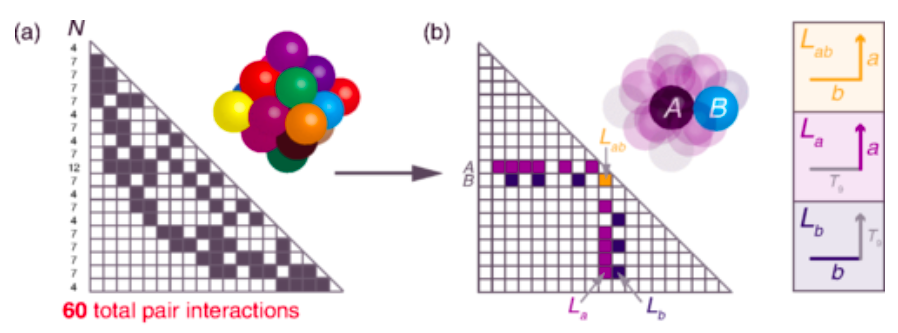Colloidal self-assembly
In our lab, we study colloidal self-assembly mediated by DNA hybridization. Inspired by Nature’s ability to make complex structures and machines, self-assembly has emerged as a powerful technique for synthesizing nanoscale materials. DNA-coated colloids provide a particularly promising approach to realizing this vision, since the base sequences grafted to the particles can be designed to encode the formation of a chosen structure. In recent years, significant progress has been made in programming nanometer- and micrometer-scale colloidal particles to form a variety of interesting self-assembled architectures. However, realizing the full promise of programmable self-assembly—that user-prescribed structures with exotic material properties can be assembled from complex mixtures of building blocks through rational design of their interactions—remains an unsolved challenge.
We have two primary directions within this research area:
Quantifying dynamics of assembly. What are the pathways by which a disordered suspension of colloidal particles spontaneously assembles into an ordered crystal? And how do those pathways depend on the details of the interparticle interactions and the structure that forms?
Creating new interactions. How many unique components would we need to build whatever structure we want? And how could we program the mutual interactions between those components to favor the formation of our chosen target? What new types of behaviors or structures could we program if we could engineer time-dependent interactions through energy dissipation?
Quantifying the dynamics of assembly
Self-assembly describes a dynamic process by which a disordered set of components assembles into an ordered structure. But how does the ordered phase first emerge from the disordered phase? And how does it grow to become the final structure?
To answer these questions, we use a technique called “microfluidics” to create hundreds of identical water droplets, which are each filled with DNA-coated colloids. We observe each drop as its colloidal suspension transitions from the initial disordered phase to the final ordered phase, and gather data for hundreds of droplets simultaneously using an optical microscope and a digital video camera. We then quantify the rates of nucleation by doing a statistical analysis of the fraction of droplets that crystallize over time and measure rates of growth by monitoring the size of the crystals within the droplets over time.
We also perform experiments investigating self-assembly at much higher spatial resolution, which enables us to track every individual particle throughout the entire assembly process. Here we can answer new types of questions: What is the size and structure of the critical nucleus? Is the ordered phase that nucleates first the same as the final assembled structure or does nucleation and growth proceed through a series of intermediates?
These experiments are complemented by theoretical modeling and computer simulations, which we perform together in collaboration with the Hagan Group and Brandeis and the Jacobs Group at Princeton.
Creating new interactions
We are also developing new ways to prescribe the interactions between colloidal particles. Traditional approaches to controlling colloidal interactions using DNA rely on direct binding of static DNA molecules grafted to the surface of colloidal particles. However, these approaches are typically limited to prescribing a small number of interactions between just a few species and the specificity of the interactions is fixed.
With the ultimate goal of prescribing the dynamic assembly of complex, user-prescribed structures, we are advancing an alternative paradigm in which the interactions are prescribed in free DNA oligomers dissolved in solution, which we call ‘linkers.’ A complex mixture of linker sequences can prescribe multiple orthogonal binding interactions, thereby dramatically increasing the addressability needed to self-assembly asymmetric structures. We can also control the relative strengths of linker-mediated interactions by tuning the linker concentrations and temperature. In addition, the same grafted colloids can be used in a variety of structures without having to be re-synthesized.
We use the Primer Exchange Reaction (PER) to append a user-specified domain to the end of an input DNA sequence coating the particles. The process involves the reversible binding of a single-stranded DNA input (I) and a catalytic hairpin. When bound, DNA polymerase copies the hairpin sequence and appends a new domain onto the input strand, producing a longer single-stranded output (IA). Therefore, the interaction between particles changes with time as the PER reaction goes on due to the change in the grafted sequences. By tuning the hairpin concentration, we could gain a control over the rate of PER reaction, which opens up the possibility for a controllable time-dependent colloidal self-assembly.
References:
A simple method to reprogram the binding specificity of DNA-coated colloids that crystallize, P. G. Moerman, H. Fang, T. E. Videbæk, W. Benjamin Rogers, R. Schulman, arXiv (2022)
Classical nucleation and growth of DNA-programmed colloidal crystallization, A. Hensley, W. M. Jacobs, W. B. Rogers, PNAS 119 (2022) e2114050118
Two-step crystallization and solid-solid transitions in binary colloidal mixtures, H. Fang, M. F. Hagan, W. B. Rogers, PNAS 117 (2020) 27927-27933
A mean-field model of linker-mediated colloidal interactions, W. B. Rogers, The Journal of Chemical Physics 153 (2020) 124901
Self-assembly and crystallization of DNA-coated colloids via linker-encoded Interactions, J. Lowensohn, A. Hensley, M. Perlow-Zelman, W. B. Rogers, Langmuir (2020)
Linker-mediated phase behavior of DNA-coated colloids, J. Lowensohn, B. Oyarzun, G. Narvaez Paliza, B. M. Mognetti, W. B. Rogers, Physical Review X, 9 (2019) 041054





